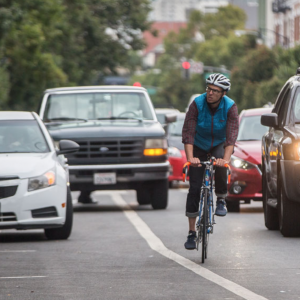 Back in June, Luz Lazo and Emily Guskin, respectively a transportation reporter and polling analyst at The Washington Post, caused a bit of a stir with a story that had the unsurprising bottom line that more Washingtonians think motorists are bad than say the same of cyclists, walkers, and scooter riders.
Back in June, Luz Lazo and Emily Guskin, respectively a transportation reporter and polling analyst at The Washington Post, caused a bit of a stir with a story that had the unsurprising bottom line that more Washingtonians think motorists are bad than say the same of cyclists, walkers, and scooter riders.
Among their findings, they discovered that drivers were more likely to fault other drivers as scofflaws than they were to complain about other road users. Cyclists, meanwhile, were nearly as critical as motorists when complaining that their fellow cyclists often break the rules of the road. Overall, the poll found that 59 percent of Washington-area residents say drivers violate traffic laws very often or almost all of the time, compared with 49 percent who say the same of bicyclists and 48 percent of pedestrians.

Scene after taxi making an illegal U-turn struck a cyclist in DC. Photo courtesy of DCist.
Much of this, as some of the poll respondents noted, is that the culture of motorists and cyclists in the District was adversarial and uncompromising. Other transportation cultures, such as that in bike-friendly Denmark, show that there is a way forward to improve road use for everyone, especially when bicycling infrastructure was available.
In May, Forbes reported that a study from the Danish Road Directorate showed that less than 5% of cyclists broke traffic laws while riding while 66% of motorists did so when driving. The Danish Cycling Embassy, a privately-funded group, puts this down to visibility: law breaking by cyclists is “easy to notice for everyone” but transgressions by motorists, such as speeding, are harder to spot. The study was carried out for the Danish government by consulting firm using video cameras sited at major junctions in Danish cities, including Copenhagen. It was found that just 4.9% of cyclists broke road rules when they were riding on cycleways. This rose to 14% of cyclists when there was no cycling infrastructure present.
Studies elsewhere in Europe, according to Forbes,also have found that the image of the law-breaking “Lycra lout” is wrong. A Transport for London study investigated the “hypothesis that the majority of cyclists ride through red lights” and discovered that 84% of cyclists stopped on reds. The study concluded that the “majority of cyclists obey red traffic lights” and that “violation is not endemic.”
FABB strongly encourages education for cyclists and motorists about the rules of the road. We always urge riders to be considerate of everyone to promote a bike culture that others will recognize, respect, and (hopefully) reciprocate. As the number of cyclists on our streets increase, motorists will take note and will become more careful. Still, the European studies suggest that bike facilities go a long way to reducing scofflaw behavior by cyclists trying to navigate and deal with often hostile automobile traffic. And we continue to work hard to expand bicycling infrastructure and connected networks in the county.
